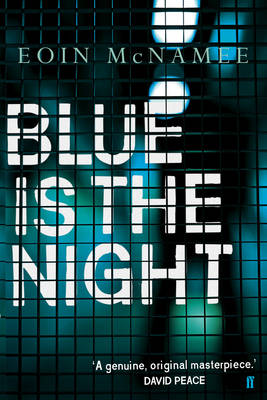
EURO CRIME
Reviews

McNamee, Eoin - 'Blue is the Night'
Trade Paperback: 272 pages (Mar. 2014) Publisher: Faber & Faber ISBN: 0571278604
1949 Belfast, Malone Road
Harry calls in to the house of Attorney General Lancelot Curran but he is not yet home. The atmosphere grows strained, whilst Harry waits, as the two Curran children try to placate the dark mood of their mother Doris. When Curran does return, Harry tells him about the Newington murder - the brutal killing of a housewife in her own home - and that a young painter and decorator has been arrested for the crime. Harry has been Curran's election agent for two years and Curran, a lover of cards and horses, needs a "minder". So when Curran insists that he will undertake the prosecution himself, Harry points out the risk to Curran's hopes for a future judgeship if he prosecutes a case involving the murder of a Catholic. Not a politic move. But Curran remains adamant.
Harry visits the accused man, Robert Taylor, at the RUC Barracks. The Barracks police are armed in case the gathering crowd try to spring him. Taylor himself is all curly hair and cheerful looks; he resembles a renowned Hollywood child star famous for singing "It's a sin to tell a lie." But Harry knows that Taylor is as wrong as they come. The murdered woman had lived for two days before succumbing to her injuries and had identified "Robert the Painter" as her killer. So Harry also knows that the only hope of salvaging Curran's career, if he insists on prosecuting Taylor, lies in somehow fixing the trial itself...
BLUE IS THE NIGHT is the third book by Irish writer Eoin McNamee to re-conjure historical events of the 1950s and 60s surrounding Northern Ireland High Court Judge and Ulster Unionist parliamentarian, Major Sir Lancelot Ernest Curran. The first two books in this loose trilogy are Booker-nominated BLUE TANGO, centring on the murder of Lance Curran's nineteen year old daughter Patricia in 1952, and ORCHID BLUE about the 1962 trial presided over by Judge Curran - of Robert McGladdery, the last man to be hanged in Northern Ireland.
This third novel's circuitous time structure requires some concentration. It centres upon the 1949 trial of Robert Taylor for the violent murder of a respectable Catholic housewife, but it also revisits 1952 - the year of Patricia Curran's murder - and the very early 1960s with Doris Curran an inmate of the mental institution which she entered shortly after the death of her daughter Patricia and where she remained for the rest of her life. In addition the novel manages a few time points before and between. But stick with it. It will be worth it.
We follow Harry Ferguson's attempts to finesse Lance Curran's involvement in the controversial 1949 murder trial in order to preserve the his political and legal career. McNamee writes a disturbing but convincing portrait of Robert Taylor, the charming and callous "accused". He also paints a precocious, rebellious, teen-aged Patricia, Curran's daughter, who skips school to attend the trial. In the 1960s section, McNamee's writing of the changes that overcome the older Doris as she is inhabited by her interior personalities is striking and chilling.
In all, this book is absorbing in its evocation of its characters. But it is the book's elliptical structure that allows McNamee to focus once more on the murder of Curran's daughter (a mystery never truly solved despite the subsequent trial of young airman Iain Hay Gordon, his discrete release six years later and eventual pardon in 2000). And also enables McNamee to examine the pervasive nature of corruption, a subject that fascinates him. The result is a dark portrait of political and psychological corruption emerging from historical events. I am also sure that the novel's style and structure would enable one to read it and to return to an earlier part of the trilogy without difficulty. It is as if BLUE IS THE NIGHT is written as just one of a set of mirrors displaying different aspects of a reflected subject. Written in a distinctive, clear, almost poetic prose that I found a pleasure to read, this book and its writer Eoin McNamee is a class act in the school of re-imagining past events.
Lynn Harvey, England
March 2014
Details of the author's other books with links to reviews can be found on the Books page.
More European crime fiction reviews can be found on the Reviews page.